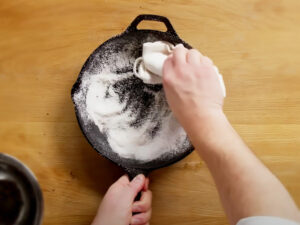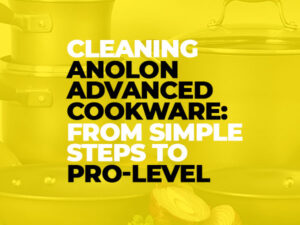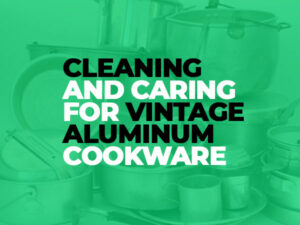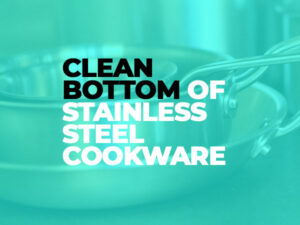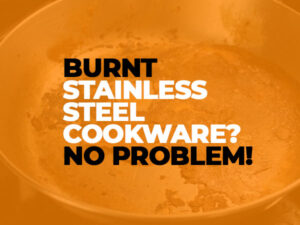Hard anodized cookware has become a go-to among home chefs due to its durability, nonstick properties, and resistance to scratches and wear. Unfortunately, even the toughest cookware can succumb to burnt food stains which are unsightly and difficult to remove. Have you ever found yourself facing the problem of burnt food residue on your hard anodized pots and pans? Fear not! With the proper techniques and tools, restoring your cookware to its former glory is simple.
In this guide, we’ll guide you through the step-by-step process of cleaning burnt hard anodized cookware effectively and without causing any harm. From gathering the necessary supplies to prepping for cleaning, using various techniques and post-cleaning care – we have everything covered so that your pans shine once more! Let’s dive in together to discover the best practices for cleaning burnt hard anodized cookware.
Gather Your Supplies: Essential Tools for Cleaning Burnt Hard Anodized Cookware
When it comes to cleaning burnt hard anodized cookware, having the appropriate supplies on hand is essential. Not only will having these tools and cleaners make the process simpler and more effective, but they will also protect the cookware’s integrity. Here are some essential items you’ll need before beginning to tackle any food stains:
- Soft cloths or non-abrasive sponges: Abrasive materials like steel wool or harsh scrub brushes can scratch the surface of hard anodized cookware, diminishing its non-stick properties. To avoid any damage, opt for soft clothes or non-abrasive sponges.
- Mild Dish Soap: Mild dish soap is ideal for cleaning hard anodized cookware. Steer clear of harsh detergents or cleaners that contain bleach or abrasives, as these can damage the surface of your cookware.
- Vinegar or lemon juice: These acidic substances can be highly effective at removing burnt food stains from hard anodized cookware. The acidity helps break down the residue, making it easier to clean. You can use white vinegar or freshly squeezed lemon juice as a natural and safe cleaning agent.
- Baking Soda: Baking soda is an inexpensive and versatile household item that can work wonders in lifting burnt food stains. It acts as a gentle abrasive, gently lifting tough spots without scratching cookware surfaces.
- Cookware Cleaner (Optional): If you would prefer to use a specialized cookware cleaner, look for one specifically designed for hard anodized cookware. Follow the manufacturer’s instructions for optimal results.
- Hot Water: Hot water can be an incredibly useful tool for softening burnt residue and making cleaning easier. Make sure you always have access to hot water, either through your faucet or by heating it separately.
Gathering all necessary supplies before beginning to clean will not only make the process smoother, but it will also protect your hard anodized cookware from potential damage and keep it looking pristine for years to come. With the correct tools and cleaners on hand, you’ll be ready to tackle burnt food stains on hard anodized cookware with confidence.
Setting Up for Cleaning: Steps to Take Before Attacking Burnt Food Stains
Before beginning the actual cleaning process, it’s essential to take some preemptive measures in order to guarantee an efficient and secure approach when dealing with burnt hard anodized cookware stains. Here are some steps you should take before taking on these tough food stains:
Be patient: Never attempt to clean burnt cookware while it’s still hot. Allow the pots and pans to cool completely to room temperature before beginning the cleaning process; this not only protects your hands from burns but also prevents further surface damage.
Remove Excess Food Debris: Use a plastic or wooden spatula to gently scrape away any burned-on food debris from cookware. Be mindful not to use any abrasive materials or sharp objects that could scratch the hard anodized surface.
Assess the Severity of Burnt Stains: Take a close look at your burnt stains to assess their severity. If they’re minor and superficial, cleaning may be easier; however, if the spots are stubborn and deeply embedded, more intensive methods or multiple passes may be needed to get rid of them.
Check Manufacturer’s Instructions: Be sure to refer to the instructions or care manual that came with your hard anodized cookware for all cleaning guidelines or restrictions that must be followed in order to maintain its warranty and prevent damage.
Protect Your Hands and Surfaces: Wear gloves to shield your hands from potentially hazardous chemicals or hot water. Also, place a towel or protective mat underneath cookware to catch drips or spills and protect countertops or sinks from scratches.
By taking these preventive steps, you can guarantee a careful and efficient cleaning process. Assessing the severity of burnt stains and following the manufacturer’s instructions will help determine the most suitable method for cleaning hard anodized cookware without causing any damage. Protecting hands and surfaces also contributes to a secure, clean experience during this step.
Cleaning Techniques: Step-by-Step Instructions for Removing Burnt Residue
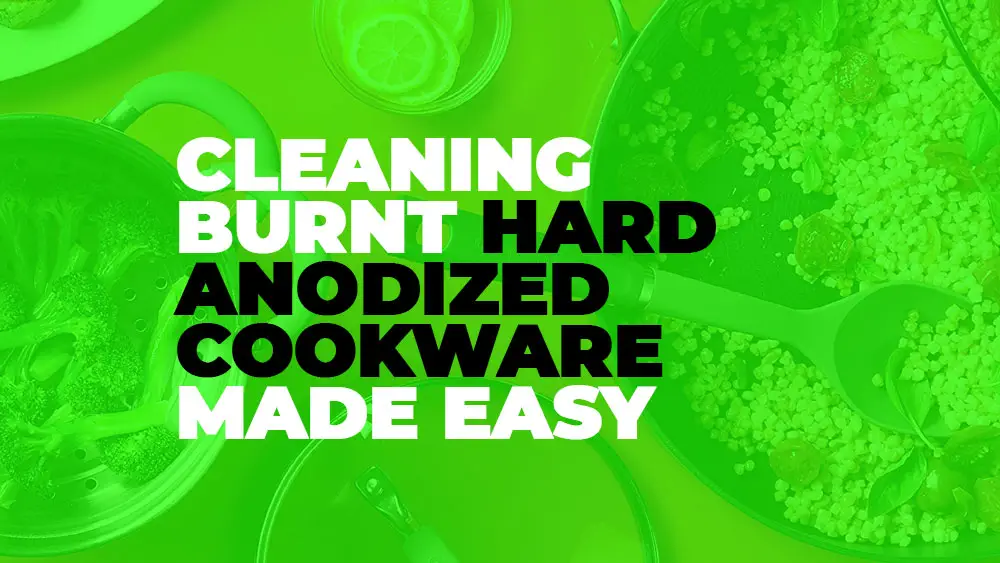
Cleaning burnt hard anodized cookware requires patience and the correct techniques in order to effectively remove the burnt residue without damaging its surface. Here are step-by-step instructions for cleaning burnt hard anodized cookware:
Step 1: Soak the Cookware
Fill the burnt cookware with warm water and add a few drops of mild dish soap. Soaking should last anywhere from 30 minutes to an hour, helping loosen any burnt residue and making cleaning much simpler.
Step 2: Add Vinegar or Lemon Juice
If the burnt stains on your cookware are stubborn, vinegar or lemon juice can help break down the burnt residue. Simply mix equal parts water and vinegar/lemon juice in a spray bottle and spray onto the affected areas of the cookware. Let sit for several minutes so the acid works its magic, then scrub gently with a soft cloth or non-abrasive sponge before rinsing thoroughly with water.
Step 3: Try Baking Soda
Baking soda is an effective abrasive for removing burnt stains from hard anodized cookware. Make a paste by mixing baking soda with water until you achieve a thick consistency, then apply onto affected areas and let sit for 15-20 minutes. Scrub gently with either a soft cloth or non-abrasive sponge, then rinse thoroughly with water.
Step 4: Use Cookware Cleaner (Optional)
If you choose to use a specialized cookware cleaner, make sure it is specifically designed for hard anodized cookware and follow the manufacturer’s instructions. Apply the cleaner onto burnt areas of the cookware and gently rub with either a soft cloth or non-abrasive sponge. Rinse thoroughly with water.
Step 5: Use a Non-Abrasive Sponge or Cloth to Scrub with.
Once you’ve soaked, used vinegar or lemon juice, attempted baking soda or used a cookware cleaner (if desired), it’s time to gently scrub away burnt residue with a non-abrasive sponge or soft cloth, applying light pressure. Be gentle as not to scratch the hard anodized surface with steel wool, abrasives brushes or other harsh materials.
Step 6: Rinse Thoroughly
After scrubbing, thoroughly rinse the cookware with hot water to eliminate any soap residue, vinegar, lemon juice, baking soda or cleaner you used. Be sure to get all areas including handles and edges rinsed so no cleaning agents remain behind.
Step 7: Dry the Cookware
Once all cookware has been rinsed thoroughly, use a clean, dry towel or cloth to completely dry it. Moisture can lead to water spots or discoloration if not completely dried before storing or using again.
Step 8: Repeat This Process If Necessary
If the burnt stains are still evident after your initial attempt at cleaning, you may need to repeat the procedure. You can try soaking for longer periods of time, using a more concentrated solution of vinegar or lemon juice, or creating a thicker paste with baking soda. Be patient and persistent; avoid harsh methods that could damage the cookware.
Step 9: Regular Maintenance
To prevent burnt food stains in the future, regular maintenance of hard anodized cookware is key. Avoid using high heat settings as this can cause food to burn and stick to the pan; instead, use medium to low temperatures and monitor cooking closely. Furthermore, steer clear of metal utensils that might scratch or dent the nonstick coating; instead opt for plastic, silicone, or wooden options which won’t scratch it as easily.
Step 10: Season Your Cookware
Seasoning your hard anodized cookware can help prevent food from sticking and burning onto the surface. To do so, coat the interior of the pan with a thin layer of vegetable oil or cooking spray and heat on low to medium heat for several minutes. Allow cooling completely before wiping away excess oil with a paper towel. This process creates a protective layer on top, making it less vulnerable to burnt food stains and easier to clean afterwards.
See Also: The Bottom Line on Cleaning Stainless Steel Cookware: A Comprehensive Guide to Gleaming Results
Post-Cleaning Care: Prolong the Life of Your Hard Anodized Cookware
After successfully cleaning your burnt hard anodized cookware, it’s essential to provide post-cleaning care in order to extend its longevity and keep it in top condition. Regular maintenance and care can extend the usefulness of your cookware while ensuring optimal performance. Here are some essential tips for proper post-cleaning care of hard anodized cookware:
Thoroughly Dry Your Cookware Before Storing It: After cleaning your cookware, be sure to thoroughly dry it before storing it. Moisture can damage the hard anodized coating and encourage mold and bacteria growth, so use a clean towel or allow the cookware to air dry completely before storing.
Avoid Stacking Hard Anodized Cookware: Stacking hard anodized cookware can cause scratches or dents on the surface, which could harm the nonstick coating. To avoid this, store each piece separately with a soft cloth or paper towel between each one for protection.
Use Appropriate Utensils: Always use non-metallic, non-abrasive utensils such as silicone, wood or nylon to avoid scratching the hard anodized surface. Metal objects can damage the non-stick coating and impair its performance.
Avoid High Heat: Although hard anodized cookware is designed to withstand high heat, it’s still important to use caution when using excessive settings. Excessive heat can cause food to burn and stick to the surface of a pan, making cleanup much harder. Stick with medium to low temperature settings when cooking and avoid preheating an empty pan for extended periods of time.
Regular Seasoning: Seasoning hard anodized cookware after each cleaning helps maintain its nonstick properties and prevents food from sticking. Simply apply a thin layer of vegetable oil or cooking spray onto the interior of the cookware and heat for several minutes on low to medium heat, allowing it to cool before wiping away excess oil.
Clean With Care: When caring for your hard anodized cookware, always use gentle techniques with non-abrasive sponges or cloths. Avoid harsh chemicals or materials that could scratch or damage the surface. Follow the manufacturer’s recommended cleaning methods to guarantee proper care.
By following these post-cleaning care tips, you can extend the life of your hard anodized cookware and keep it in excellent condition for years to come. Not only will proper care and maintenance protect its nonstick properties, but it will also guarantee its durability and performance over time.
FAQs
Can I use abrasives or harsh chemicals to clean burnt hard anodized cookware?
It is not advised to use abrasives or harsh chemicals on hard anodized cookware, as they can scratch or damage the surface. For best results, utilize non-abrasive sponges or cloths and follow your manufacturer’s recommended cleaning methods. You could try soaking cookware in hot water with some dish soap or vinegar for several hours to loosen burnt residue before gently scrubbing with a non-abrasive sponge or cloth. Alternatively, make a paste out of baking soda and water or lemon juice and salt which you can use for stubborn burnt stains.
How can I remove burnt food stains from hard anodized cookware?
To remove burnt food stains from hard anodized cookware, try soaking it in hot water with dish soap or vinegar for several hours. Gently scrub with a non-abrasive sponge or cloth. If the stains are stubborn, make a paste out of baking soda, water, lemon juice and salt – then use that to scrub away stubborn spots. Avoid using abrasives or harsh chemicals as these could damage the surface of your cookware.
Can metal utensils be used on hard anodized cookware?
Metal utensils should never be used on hard anodized cookware as they may scratch or damage the non-stick coating. Instead, opt for non-metallic, non-abrasive materials like silicone, wood or nylon to avoid scratching your dishware. Metal utensils cause scratches that degrade its non-stick properties and reduce its lifespan.
How do I remove burnt residue from the exterior of hard anodized cookware?
To remove burnt residue from hard anodized cookware, start by soaking the affected area in hot water for several minutes to loosen any stubborn stains. Then use a non-abrasive sponge or cloth with mild dish soap and circular motions to scrub away at the area in circular motion. Be gentle as not to scratch or damage the surface of the cookware by using abrasives or harsh chemicals. If stubborn stains persist, mix baking soda and water into a paste and use that as your scrubby; make sure all traces are gone before drying with clean towels to prevent water spots.
How often should I season my hard anodized cookware?
Seasoning hard anodized cookware after each cleaning helps preserve its nonstick properties. All you have to do is apply a thin layer of vegetable oil or cooking spray onto the interior and heat on low to medium heat for several minutes; allow to cool before wiping away excess oil. Seasoning helps replenish the non-stick coating and prevents food from sticking to the surface, ensuring optimal performance from your cookware. For best results, always check the manufacturer’s instructions for specific care instructions specific for hard anodized cookware.
Final Verdicts
Cleaning burnt hard anodized cookware requires precision and skill. Soaking with vinegar or lemon juice, trying baking soda, or using a cookware cleaner (if desired) followed by gentle scrubbing with a non-abrasive sponge or cloth, thorough rinsing, and complete drying are essential steps in the process. Regular maintenance such as avoiding high heat settings, using appropriate utensils, and seasoning the pan can help prevent future burnt food stains from returning.
It is essential to always follow the manufacturer’s instructions when cleaning and maintaining your hard anodized cookware, as different brands may have differing guidelines. Steer clear of abrasives or harsh chemicals which could scratch or damage the surface. With proper care and upkeep, your hard anodized cookware can last for years, providing you with reliable cooking experiences. So grab some supplies and follow these simple step-by-step instructions to effectively clean burnt hard anodized cookware and keep it looking like new!


